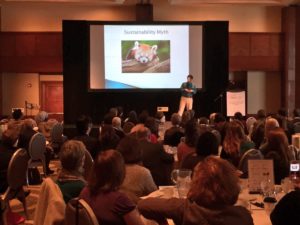The relationship between funders and nonprofits needs to change — and slowly, it is
 December 8, 2016
Category: Feature, Featured, Funding, Medium
December 8, 2016
Category: Feature, Featured, Funding, Medium
Disclosures
Full disclosure: Editor Julie Zeglen, who wrote this story, was a finalist for Impact100 Philadelphia's Founders Fellowship Program for the 2016-2017 cycle, but is not currently affiliated with the organization.In between PowerPoint slides with pictures of baby animals and absurd comparisons of the impact sector to “Game of Thrones,” Seattle nonprofit guru Vu Le had some serious words of criticism for funders in his keynote speech at Philanthropy Network’s fall conference last month.
Among a plethora of calls-to-action, the “Nonprofit with Balls” blogger asked funders to:
- Get real about what it takes to run a nonprofit: Le blasted both the overhead myth and the sustainability myth — that if funders keep funding the same nonprofits, those nonprofits will grow reliant on them and not be sustainable in the long term. “The focus on sustainability is one of the biggest threats to sustainability itself,” he said, to massive applause.
- Fund faster: For many small organizations, it’s not helpful to get a grant if it takes several months to actually access the money — they’ll fall apart in the meantime.
- Get comfortable with uncomfortable conversations about inequity and power dynamics: Funders are the ones with the power in this relationship. Address it.
Above all, though, he begged for more trust-based grantmaking — that is, less of funders telling nonprofits how they should be spending their money, and more of funders letting nonprofits spend the money wherever it’s needed most. Descriptive grantmaking, rather than prescriptive.
It’s something that some funders, such as the Barra Foundation, have been doing for a while. In fact, Barra President Tina Wahl told us last year that she believes unrestricted funding is vital to the nonprofit sector’s health. And in its recent announcement of 2016-2017 grantees, the organization stated, “we recognize the importance of unrestricted funding to nonprofit organizations — particularly as they must continually adapt and evolve to a changing environment.”
It’s something giving circle Impact100 Philadelphia recognizes, too. That’s why it’s changing its funding model from project-specific grants to “core mission grants.” It’s still focusing its funding on organizations working in one of five areas (arts and culture, family, education, environment, and health and wellness), and its grant sizes haven’t changed ($100,000 to three top finalists, $30,000 in general operating grants to two runners-up and the remainder split between the three top finalists).
But now, Impact100, which has distributed over $2 million over eight grant cycles since 2008, will no longer that require its grants be used only for programmatic expenses. Now, they can be applied to any organizational need — for instance, facilities upgrades, operations, staff support or technology.
It won’t offer unrestricted funds per se, said grants co-chair Emily Biscardi: The nonprofits that are granted $100,000 must still apply the money the way they say they will in their proposals. But they’re no longer tied to using it for programming only.
Impact100 is also extending the period in which grantees must spend the money from 15 months to 24 months to lessen the stress of adhering to its rules for smaller nonprofits with smaller budgets.
The organization came to these conclusions during its strategic planning process in anticipation of its 10th anniversary, happening next year, while asking itself how it could better support the needs of the nonprofit community through its grantmaking, Biscardi said.
“Instead of having us tell the nonprofits, ‘This is the best use of [our] money, we’re empowering them and letting them tell us where the money is best used,” she said. (Et tu, Vu?)
Impact100 adopted much of the language it uses to describe its funding shift from a Nonprofit Quarterly article titled, “A Graphic Re-visioning of Nonprofit Overhead.” Author Curtis Klotz imagines nonprofit spending not as a pie chart, but as a series of circles, the center of which reads “core mission support — fundraising and partners.”
That article came out in August. Philanthropy Network’s conference was held in November. Impact100 first announced the intended change to its members in June. Accordingly, “we feel like we’re on the forefront of this shift,” Biscardi said — a shift that resulted from conversations with their grantees, other nonprofits and other funders about changing needs.
Impact100’s members are excited about this shift — as are the nonprofits they serve.
“They’re beyond excited about the concept and feel like Impact100 is really supporting their needs in going in this direction,” she said.
Trending News










